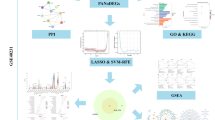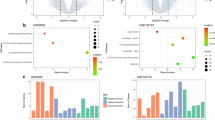Abstract
The aim of this study was to investigate the role of miR-21 in inflammatory responses in peripheral blood mononuclear cells (PBMCs) of type 2 diabetic (T2D) and healthy subjects. 20 healthy and 20 T2D subjects were enrolled in the study. miR-21 expression in PBMCs of the subjects was measured using real-time PCR. IL-6 and TNF-α levels in culture supernatants were quantified using ELISA. miR-21 expression was not significantly different between the diabetic and nondiabetic groups. A downregulation of miR-21 expression was observed in PBMCs of obese subjects in both diabetic and nondiabetic groups. In addition, miR-21 expression was negatively correlated with weight, waist circumference, body mass index, and triglyceride in both the diabetic and nondiabetic groups. Our results also demonstrated that the PBMCs of obese subjects significantly secreted a higher level of IL-6 and TNF-α in comparison with the PBMCs of nonobese subjects. Furthermore, a significant inverse correlation between miR-21 expression and TNF-α and IL-6 production from the PBMCs was observed. These data suggest that miR-21 expression is decreased in PBMCs of obese subjects and reduced expression appears to be associated with increased secreted cytokine level in media of PBMCs of obese subjects.




Similar content being viewed by others

Abbreviations
- BMI:
-
Body mass index
- FBS:
-
Fasting blood sugar
- IL-6:
-
Interleukin 6
- IL-1β:
-
Interleukin 1β
- IL-10:
-
Interleukin 10
- IL-4:
-
Interleukin 4
- IL-13:
-
Interleukin 13
- LPS:
-
Lipopolysaccharide
- miR-21:
-
MicroRNA-21
- NF-κB:
-
Nuclear factor kappa B
- PBMCs:
-
Peripheral blood mononuclear cells
- TNF-α:
-
Tumor necrosis factor alpha
- TLR-4:
-
Toll-like receptor-4
- T2D:
-
Type 2 diabetes
- WC:
-
Waist circumference
References
Shaw JE, Sicree RA, Zimmet PZ (2010) Global estimates of the prevalence of diabetes for 2010 and 2030. Diabetes Res Clin Pract 87:4–14. doi:10.1016/j.diabres.2009.10.007
Khodabandehloo H, Gorgani-Firuzjaee S, Panahi G, Meshkani R (2016) Molecular and cellular mechanisms linking inflammation to insulin resistance and beta-cell dysfunction. Transl Res 167:228–256. doi:10.1016/j.trsl.2015.08.011
Meshkani R, Adeli K (2009) Mechanisms linking the metabolic syndrome and cardiovascular disease: role of hepatic insulin resistance. J Tehran Univ Heart Cent 4:77–84
Saberi H, Mohammadtaghvaei N, Gulkho S, Bakhtiyari S, Mohammadi M, Hanachi P, Gerayesh-Nejad S, Zargari M, Ataei F, Parvaneh L, Larijani B, Meshkani R (2011) The ENPP1 K121Q polymorphism is not associated with type 2 diabetes and related metabolic traits in an Iranian population. Mol Cell Biochem 350:113–118. doi:10.1007/s11010-010-0687-z
Olefsky JM, Glass CK (2010) Macrophages, inflammation, and insulin resistance. Annu Rev Physiol 72:219–246. doi:10.1146/annurev-physiol-021909-135846
Hulsmans M, De Keyzer D, Holvoet P (2011) MicroRNAs regulating oxidative stress and inflammation in relation to obesity and atherosclerosis. FASEB J 25:2515–2527. doi:10.1096/fj.11-181149
Wang Y, Russell I, Chen C (2009) MicroRNA and stem cell regulation. Curr Opin Mol Ther 11:292–298
Zhou X, Wang X, Huang Z, Wang J, Zhu W, Shu Y, Liu P (2014) Prognostic value of miR-21 in various cancers: an updating meta-analysis. PLoS One 9:e102413. doi:10.1371/journal.pone.0102413
Cheng Y, Zhang C (2010) MicroRNA-21 in cardiovascular disease. J Cardiovasc Transl Res 3:251–255. doi:10.1007/s12265-010-9169-7
Selcuklu SD, Donoghue MT, Spillane C (2009) miR-21 as a key regulator of oncogenic processes. Biochem Soc Trans 37:918–925. doi:10.1042/BST0370918
Keller P, Gburcik V, Petrovic N, Gallagher IJ, Nedergaard J, Cannon B, Timmons JA (2011) Gene-chip studies of adipogenesis-regulated microRNAs in mouse primary adipocytes and human obesity. BMC Endocr Disord 11:7. doi:10.1186/1472-6823-11-7
Li S, Chen X, Zhang H, Liang X, Xiang Y, Yu C, Zen K, Li Y, Zhang CY (2009) Differential expression of microRNAs in mouse liver under aberrant energy metabolic status. J Lipid Res 50:1756–1765. doi:10.1194/jlr.M800509-JLR200
Mazloom H, Alizadeh S, Pasalar P, Esfahani EN, Meshkani R (2015) Downregulated microRNA-155 expression in peripheral blood mononuclear cells of type 2 diabetic patients is not correlated with increased inflammatory cytokine production. Cytokine 76:403–408. doi:10.1016/j.cyto.2015.07.007
Dong L, Wang X, Tan J, Li H, Qian W, Chen J, Chen Q, Wang J, Xu W, Tao C, Wang S (2014) Decreased expression of microRNA-21 correlates with the imbalance of Th17 and Treg cells in patients with rheumatoid arthritis. J Cell Mol Med 18:2213–2224. doi:10.1111/jcmm.12353
Lu TX, Sherrill JD, Wen T, Plassard AJ, Besse JA, Abonia JP, Franciosi JP, Putnam PE, Eby M, Martin LJ, Aronow BJ, Rothenberg ME (2012) MicroRNA signature in patients with eosinophilic esophagitis, reversibility with glucocorticoids, and assessment as disease biomarkers. J Allergy Clin Immunol 129(1064–75):e9. doi:10.1016/j.jaci.2012.01.060
Lu TX, Hartner J, Lim EJ, Fabry V, Mingler MK, Cole ET, Orkin SH, Aronow BJ, Rothenberg ME (2011) MicroRNA-21 limits in vivo immune response-mediated activation of the IL-12/IFN-gamma pathway, Th1 polarization, and the severity of delayed-type hypersensitivity. J Immunol 187:3362–3373. doi:10.4049/jimmunol.1101235
Iliopoulos D, Jaeger SA, Hirsch HA, Bulyk ML, Struhl K (2010) STAT3 activation of miR-21 and miR-181b-1 via PTEN and CYLD are part of the epigenetic switch linking inflammation to cancer. Mol Cell 39:493–506. doi:10.1016/j.molcel.2010.07.023
Sheedy FJ, Palsson-McDermott E, Hennessy EJ, Martin C, O’Leary JJ, Ruan Q, Johnson DS, Chen Y, O’Neill LA (2010) Negative regulation of TLR4 via targeting of the proinflammatory tumor suppressor PDCD4 by the microRNA miR-21. Nat Immunol 11:141–147. doi:10.1038/ni.1828
Feng J, Li A, Deng J, Yang Y, Dang L, Ye Y, Li Y, Zhang W (2014) miR-21 attenuates lipopolysaccharide-induced lipid accumulation and inflammatory response: potential role in cerebrovascular disease. Lipids Health Dis 13:27. doi:10.1186/1476-511X-13-27
Catalan V, Gomez-Ambrosi J, Rodriguez A, Ramirez B, Valenti V, Moncada R, Silva C, Salvador J, Fruhbeck G (2015) Peripheral mononuclear blood cells contribute to the obesity-associated inflammatory state independently of glycemic status: involvement of the novel proinflammatory adipokines chemerin, chitinase-3-like protein 1, lipocalin-2 and osteopontin. Genes Nutr 10:460. doi:10.1007/s12263-015-0460-8
Olivieri F, Rippo MR, Prattichizzo F, Babini L, Graciotti L, Recchioni R, Procopio AD (2013) Toll like receptor signaling in “inflammaging”: microRNA as new players. Immun Ageing 10:11. doi:10.1186/1742-4933-10-11
Lee YS, Dutta A (2009) MicroRNAs in cancer. Annu Rev Pathol 4:199–227. doi:10.1146/annurev.pathol.4.110807.092222
Yan LX, Huang XF, Shao Q, Huang MY, Deng L, Wu QL, Zeng YX, Shao JY (2008) MicroRNA miR-21 overexpression in human breast cancer is associated with advanced clinical stage, lymph node metastasis and patient poor prognosis. RNA 14:2348–2360. doi:10.1261/rna.1034808
Si ML, Zhu S, Wu H, Lu Z, Wu F, Mo YY (2007) miR-21-mediated tumor growth. Oncogene 26:2799–2803. doi:10.1038/sj.onc.1210083
Zhong X, Chung AC, Chen HY, Dong Y, Meng XM, Li R, Yang W, Hou FF, Lan HY (2013) miR-21 is a key therapeutic target for renal injury in a mouse model of type 2 diabetes. Diabetologia 56:663–674. doi:10.1007/s00125-012-2804-x
Thum T, Gross C, Fiedler J, Fischer T, Kissler S, Bussen M, Galuppo P, Just S, Rottbauer W, Frantz S, Castoldi M, Soutschek J, Koteliansky V, Rosenwald A, Basson MA, Licht JD, Pena JT, Rouhanifard SH, Muckenthaler MU, Tuschl T, Martin GR, Bauersachs J, Engelhardt S (2008) MicroRNA-21 contributes to myocardial disease by stimulating MAP kinase signalling in fibroblasts. Nature 456:980–984. doi:10.1038/nature07511
Thum T, Galuppo P, Wolf C, Fiedler J, Kneitz S, van Laake LW, Doevendans PA, Mummery CL, Borlak J, Haverich A, Gross C, Engelhardt S, Ertl G, Bauersachs J (2007) MicroRNAs in the human heart: a clue to fetal gene reprogramming in heart failure. Circulation 116:258–267. doi:10.1161/CIRCULATIONAHA.107.687947
Meng S, Cao JT, Zhang B, Zhou Q, Shen CX, Wang CQ (2012) Downregulation of microRNA-126 in endothelial progenitor cells from diabetes patients, impairs their functional properties, via target gene Spred-1. J Mol Cell Cardiol 53:64–72. doi:10.1016/j.yjmcc.2012.04.003
Zampetaki A, Kiechl S, Drozdov I, Willeit P, Mayr U, Prokopi M, Mayr A, Weger S, Oberhollenzer F, Bonora E, Shah A, Willeit J, Mayr M (2010) Plasma microRNA profiling reveals loss of endothelial miR-126 and other microRNAs in type 2 diabetes. Circ Res 107:810–817. doi:10.1161/CIRCRESAHA.110.226357
Ling HY, Hu B, Hu XB, Zhong J, Feng SD, Qin L, Liu G, Wen GB, Liao DF (2012) MiRNA-21 reverses high glucose and high insulin induced insulin resistance in 3T3-L1 adipocytes through targeting phosphatase and tensin homologue. Exp Clin Endocrinol Diabetes 120:553–559. doi:10.1055/s-0032-1311644
Dicker D, Salook MA, Marcoviciu D, Djaldetti M, Bessler H (2013) Role of peripheral blood mononuclear cells in the predisposition of obese individuals to inflammation and infection. Obes Facts 6:146–151. doi:10.1159/000350775
Costinean S, Sandhu SK, Pedersen IM, Tili E, Trotta R, Perrotti D, Ciarlariello D, Neviani P, Harb J, Kauffman LR, Shidham A, Croce CM (2009) Src homology 2 domain-containing inositol-5-phosphatase and CCAAT enhancer-binding protein beta are targeted by miR-155 in B cells of Emicro-MiR-155 transgenic mice. Blood 114:1374–1382. doi:10.1182/blood-2009-05-22081
Lu Z, Liu M, Stribinskis V, Klinge CM, Ramos KS, Colburn NH, Li Y (2008) MicroRNA-21 promotes cell transformation by targeting the programmed cell death 4 gene. Oncogene 27:4373–4379. doi:10.1038/onc.2008.72
Acknowledgments
We greatly appreciate the assistance provided by the staff of the Endocrinology and Metabolism Research Institute of Tehran University of Medical Sciences. We also thank all volunteers for their participation in the study. This work was financially supported by a grant (1391-01-97-1427) from the Diabetes Research Center, Endocrinology and Metabolism Research Institute of Tehran University of Medical Sciences.
Author information
Authors and Affiliations
Corresponding author
Ethics declarations
Conflict of interest
The authors state that they have no conflict of interest.
Rights and permissions
About this article
Cite this article
Mazloom, H., Alizadeh, S., Esfahani, E.N. et al. Decreased expression of microRNA-21 is associated with increased cytokine production in peripheral blood mononuclear cells (PBMCs) of obese type 2 diabetic and non-diabetic subjects. Mol Cell Biochem 419, 11–17 (2016). https://doi.org/10.1007/s11010-016-2743-9
Received:
Accepted:
Published:
Issue Date:
DOI: https://doi.org/10.1007/s11010-016-2743-9



